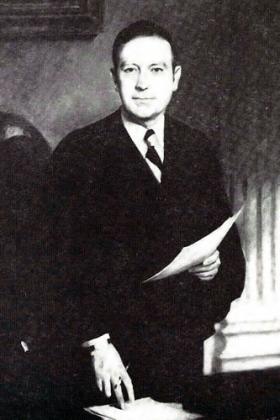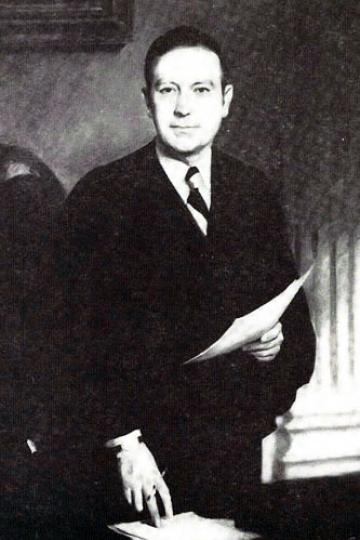

- Term: March 23, 1973 - Oct. 19, 1973
- Status: Deceased - Oct. 19, 1973
Introduction
Pierre Garven filled the void following the early retirement of Chief Justice Weintraub in August of 1973. Garven had been serving as an Associate Justice since March of the same year. Governor at the time, William T. Cahill was confident he had made a wise selection. Improvement of court practice, procedure and administration of the Judiciary were Garven’s top priorities. Unfortunately, a mere 46 days following his appointment Garven suffered a fatal stroke and departed this world far too early at the age of 47 on October 19, 1973.
As a member of the High Court and during his brief tenure Chief Justice Garven was a magnetic force of unity among his colleagues in the Judiciary, the other two branches of government, along with practicing attorneys, and the people of New Jersey. He was a man of unquestioned integrity, who set very high standards of performance, and devoted himself to making our courts function efficiently in the best interest of everyone.
Garven’s Personal Life and Career
Chief Justice Garven was born in 1925 in Bayonne. He was the son of four term Mayor Pierre P. Garven of Bayonne, and like his father, a Republican.
Garven interrupted his studies at Princeton University to become a bombardier in the Army Air Corps during World War II. Following the War, he returned to Princeton, and graduated in 1948, and then from NYU Law School in 1951.
He was admitted to the New Jersey Bar in 1952, and became an Assistant United States Attorney in 1954. From 1956 to 1968, Garven practiced law in Hackensack before being appointed Clerk to the General Assembly and Bergen County Counsel. He was then appointed to the Bergen County Court, then a Constitutional Court prior to the 1978 merger of the County Courts into the Superior Court. Ironically, he was appointed to the Bench by Governor Richard J. Hughes, the man who would succeed him as Chief Justice.
Garven was serving as a judge of the former Bergen County Court when Governor William T. Cahill was elected Governor in 1969 and sworn in to office in January, 1970. The candidacy and election of Governor Cahill, a Republican from Camden County, was substantially aided by a coalition formed with Republicans from Bergen County. The personal relationship Cahill forged with its leader, Nelson Gross, Republican State Chairman and later, Chair of the Cahill campaign, was the impetus for Garven's appointment as Counsel to the Governor.
People who knew "Pete" Garven, as he was called at the time, said he was "quiet," "low key" and "unassuming," but "thoughtful," "well liked," "well respected," and a "good administrator" "with common sense" which he would demonstrate as Chief Justice. Governor Cahill’s respect for, and reliance upon Garven was such that some people referred to Garven as "Lieutenant Governor" even though that position had yet to be created. Long before he became Chief Justice, Garven was revered by lawyers and Judges for his thoughtfulness, fairness, decency and for his sense of humor - never at someone else’s expense. As trite as the term had become, he was the quintessential "lawyer’s lawyer" and "judge’s judge" treating others as he would have wanted to be treated and applying standards of probity to which he held himself.
Garven was appointed to the Supreme Court by Governor Cahill to replace Justice John J. Francis. Garven became an Associate Justice on March 23, 1973. When Chief Justice Weintraub announced his retirement effective August 31, 1973, to spend more time with his ailing wife, Governor Cahill nominated Garven to replace him as Chief Justice. Hence, Garven served from March, 1973 through the end of the Term as an Associate Justice of the Supreme Court before becoming the youngest person, as of that time, to serve as Chief Justice under our 1947 Constitution. He was only 47. As Associate Justice, Garven joined the Court in 10 unanimous opinions. Interestingly, Court records also reflect that he joined 3 opinions in cases which were argued before he became a Justice, but which were decided while he served as Chief Justice. He also voted in 4 cases which were argued and decided while he was Chief Justice.
Major Speech Advocating Change
After taking his oath as Chief Justice, Garven addressed the New Jersey Judiciary at its then-annual educational seminar at the Cherry Hill Inn on September 5, 1973. His address was a pivotal event in the history of the Judiciary. After a period of years in which there was some strain among the three branches of government and particularly between the Bench and the Bar, the new Chief Justice praised the other branches and other participants in the system as well as the system itself and the judges.
Garven believed that it was critical to always "striv[e] for a system of justice which is fair, expedient and economical" while not overlooking the "quality of justice." To that end, he called for "the merger of county courts into the Superior Court" and the establishment of a "family court," all of which came to be. In all matters he sought to eliminate "duplicitous procedures."
In his address before the Judicial Seminar, Garven called for speedy trials in criminal cases in order to protect our citizens and society, independent of recognizing defendants' rights. He was one of the first members of our Judiciary to recognize the benefits of handling all new criminal offenses at the County level; there such matters could be subject to early case screening, downgrading of indictable offenses, and remand to municipal courts of non indictable offenses. Garven also advocated developing an enlightened plea bargaining protocol with a plea cutoff.
On the civil side, the Chief quipped "[i]f we can explore the moon and the sea, we should be capable of providing a better method of trial scheduling than presently exists,"and he added with respect to the "serious problems " in all court Divisions, "None are insurmountable, but these problems cannot dissolve or lessen through self-adulation, illusion, mirrors, half efforts, or ostrich-like gestures."
He called for study and realistic solutions to the problems with input from members of the judicial community and experts and noted further that, "We must be willing to take calculated risks, assume unknown burdens, experiment freely and move forward progressively and diligently. We must adapt our system to the changing times in a manner which is consistent with relative simplicity and fairness."
And so a renewed priority to addressing the needs of the Judiciary in serving the public was born – one that led to study, innovation, experimentation, and evaluation. It began with Chief Justice Garven’s speech at the annual conference in September, 1973. There he announced the creation of two standing Supreme Court Committees to be "composed of legal scholars, judges and lawyers" , "with more weight and responsibility" than Committees previously had. The present Civil Practice and Criminal Practice Committees were thus created "to develop, review and recommend changes in our trial court practices, not only procedural, but substantive too."
The concept of having a practice Committee chaired by a sitting Supreme Court Justice was new because it left no gap between the Committee's recommendations and the Court's independent review. Moreover, to assure meaningful results by the Committees, each was to "receive a full-time staff." Thus, were the positions of Director of Civil Practice and Director of Criminal Practice created. Finally, other innovations including an Appellate Practice Committee and the Client Security Fund (now known as the Fund for Client Protection), were announced.
Yet one of the more significant things to come out of the address was Garven’s statement that he would not be writing the number of opinions written by his predecessors Vanderbilt and Weintraub. He preferred to concentrate on his Constitutional responsibilities as administrative head of the Judiciary, "The importance of administration is second only to the necessity for competent judges. If we do not possess a highly integrated smooth-working administration, we will not succeed in our quest for judicial superiority no matter how qualified our judges may be. Responsible administrative direction is imperative. Consequently, I have determined to allot a substantial amount of my time to administrative duties."
Finally, in a speech to the conference of Municipal Court Judges two days prior to his death – read by another – Garven called for "substantial reforms " in the Municipal Court system. He recognized the political concerns of the judges, the need for more education of judges, better court facilities staffed by prosecutors and public defenders and scheduling "to accommodate our citizens and their legal representatives."
Untimely Death
Unfortunately, Garven’s devotion to these goals lasted only seven weeks as Chief Justice. Pierre Garven suffered a fatal stroke on October 16, 1973, and died three days later. He was survived by his wife, Sandra, and their five children. Yet, while serving as Chief, Garven named an experienced sitting judge, Arthur J. Simpson, Jr., as Acting Administrative Director of the Courts. Judge Simpson was the first of several judges to be named Administrative Director. He remained Acting Administrative Director through the Hughes years; together they reorganized the Administrative Office of the Courts. (Administrative Director and Judge are "Constitutional Officers". A person cannot hold two Constitutional Offices simultaneously, thus the term "acting".)
In sum, Pierre Garven created a lasting Committee structure and administrative protocol designed to improve the Court system. He realized the need for the professional administration of the Judiciary as a priority undertaking of our Chief Justices under that office’s unique Constitutional powers as administrative head of the Judiciary.